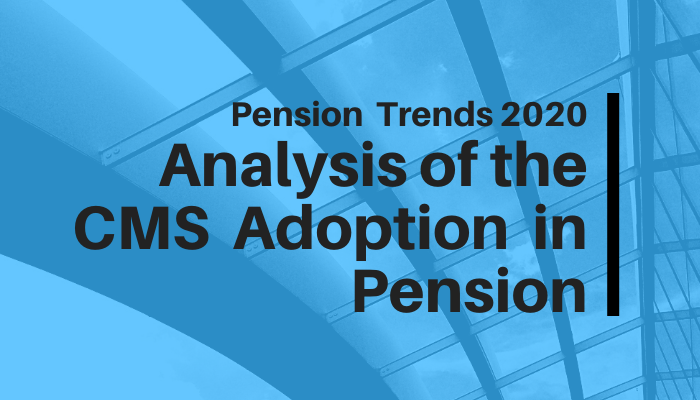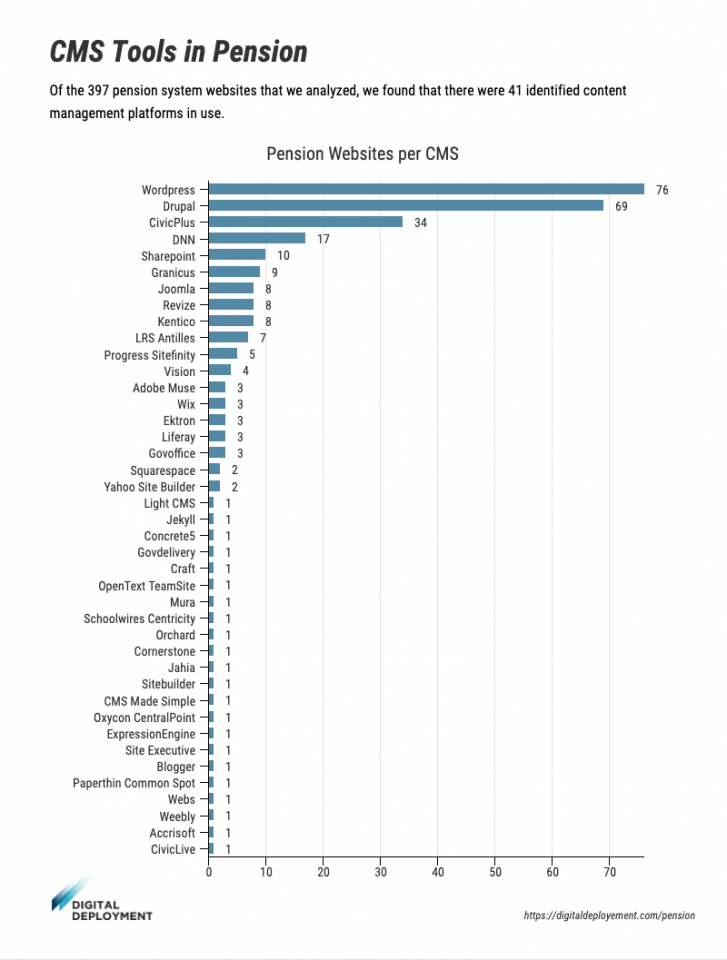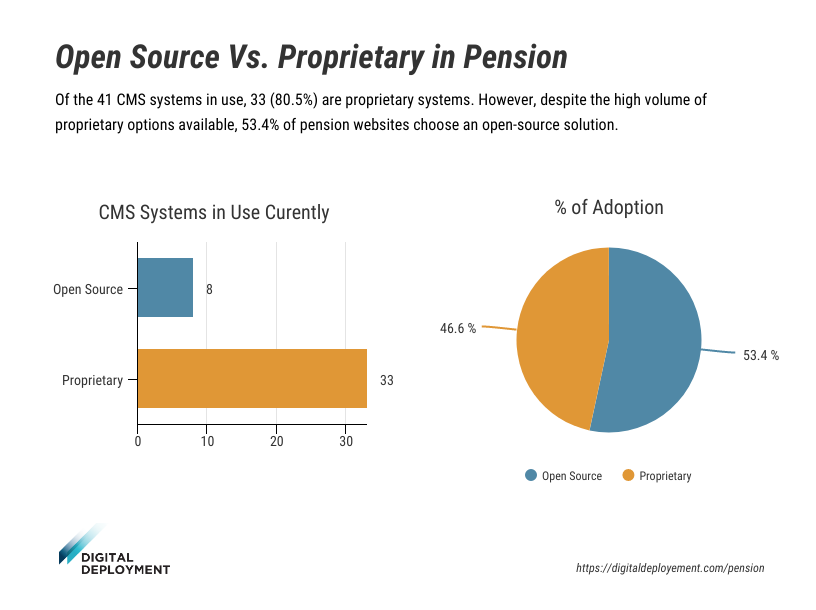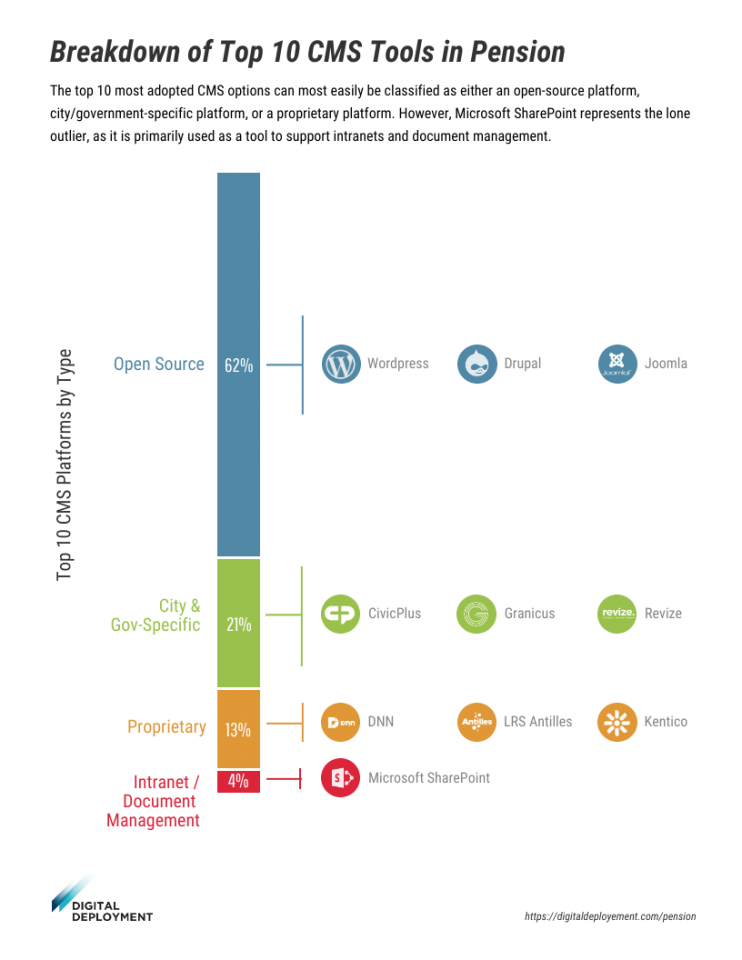The Most Popular Content Management Systems in Pension — 2020
There are lots of options when choosing a content management system (CMS) for your public-facing pension system website. From open or closed source to flexibility, from ease-of-use to security and performance, there is a lot to consider! To make this process a bit easier, we took a deep dive to better understand what tools pension systems in 2020 are using to power their public websites.
How we evaluated CMS usage
By working with our pension partners in cities, counties, states, police, and fire organizations across the country, we were able to compile a database of nearly 400 retirement systems throughout the United States and Canada. No system was too big or too small for this exercise. Once our list was assembled, we carefully researched each website to understand what CMS platform or website tools they were using. The results were fascinating.
What we learned
- Pension systems are using over 40 different CMS platforms.
- 25% of pension system websites do not have an identifiable CMS platform.
- 53% of pension systems choose an open-source solution.
- Top 10 CMS platforms account for 83% of actual CMS usage.
- The 10 most adopted options fall into a few key groups.
- 11% pension websites are currently using a CMS platform that will reach its end-of-life within the next year.
Have questions about your CMS or pension website strategy? Schedule a quick chat with our team.
The CMS landscape for pension systems is quite a bit wider than we would have initially expected.
Of the 397 pension system websites that we analyzed, we found that there were 41 different software platforms in use. Initially this surprised us, but as we dove deeper into the data, things became a bit more clear.
Download slides of the key findings to share with your team
There are several pension systems that are currently housed within their city’s or county’s website. For many sites in this circumstance, this means that they are forced to work within the city or government CMS that was chosen.
Beyond this, we also found that the website redesign cycle for public pension websites appears to be a bit longer than in similar industries. Many of the sites that we audited had not been redesigned in well over five years, which contributes to the selection of older, and potentially end-of-life CMS solutions in use.
Surprisingly, 101 (25.4%) of the pension systems evaluated did not have any identifiable CMS tool in place to power their website.
With so many options out there it would be wise for these systems to consider implementing a modern CMS for their first website, or during their next redesign. Modern CMS options offer a lot of important advantages including agile publishing for important news and events, responsive design to establish an excellent member experience on any device, important ADA compliance considerations, and more.
In future articles, we’ll discuss the criteria that pension systems should consider when selecting their next CMS. However, if you have immediate questions, just let us know and we’ll be happy to help.
Despite the high number of proprietary CMS platforms that made the list, 53% of pension systems choose open-source.
Of the 41 different types of website platforms in use, 33 of them are considered proprietary (or closed-source) systems. However, despite the high number of proprietary options available, the decision to choose open-source vs. proprietary is nearly split down the middle.
There are distinct advantages to selecting either a proprietary or open-source CMS, including things like cost per user, portability, support, and more. We’ll be discussing this in greater depth in future articles.
The top 10 tools account for 83% of actual CMS usage.
Though we initially saw a high number of platform options in pension, the market has largely settled on a select few that best fit the needs of the industry. If you’re shopping for a website platform down the road, this should make your decision a bit easier.
The 10 most adopted options fall into a few key groups.
There are many factors at play when selecting a CMS, but it is much easier if you can realize which group best fits your needs. Within the top 10 choices we found the following options:
Open-source (Wordpress, Drupal, Joomla)
This group accounts for 62% of the top 10 CMS platforms in pension. As a whole, they are prized for their high-customizability, assurance of data portability, lack of licensing fee, active development communities, and more.
City/Government-Specific Platforms (CivicPlus, Revize, Granicus, Streamline)
City/Government-Specific Platforms are the second-largest grouping of CMS platforms in pension. This appears to be largely due to pension systems that share a website with their city or county. However, there are standalone organizations that are choosing these solutions as well. One benefit to these systems is the inclusion of a few key tools like board meetings and agenda management.
Proprietary CMS platforms (DNN, LRS Antilles, Kentico)
Outside of open-source and government platforms, there are a handful of organizations that choose one of the proprietary systems listed above. These are often Microsoft shops as both DNN and Kentico are built upon Microsoft’s .NET framework. This presents some potentially valuable integrations between Microsoft products. However, in practice, organizations may be reluctant to integrate .NET business applications with their public website for security reasons.
Intranet/Document Management Platform (SharePoint)
Despite not actually being classified as a CMS, there are a number of systems that choose Microsoft SharePoint to manage their systems. This is likely for its strong document management capabilities.
Roughly 11% of pension websites are currently using a CMS platform that will reach its end-of-life within the next year.
Choosing the right technology and planning your upgrade path is key when selecting a CMS platform. Of the CMS platforms in use, each of the following will reach their end-of-life within the next year.
- Drupal 7
- Sharepoint 2010
- Adobe Muse
- Light CMS
The impact of Drupal 7’s sunset will be the most significant as 55% of the Drupal-powered pension sites we analyzed are currently using that version of the CMS.
Have questions, ideas for future articles, or feedback to share?
We feel like we’ve barely scratched the surface on this topic and look forward to diving in further with future articles. Thanks for joining for our first edition! In our next article, we’ll dive deeper into the criteria pension systems should use to pick their next CMS.
If you have any questions about this topic or anything else related to your website, feel free to reach out. We’re always happy to help!





